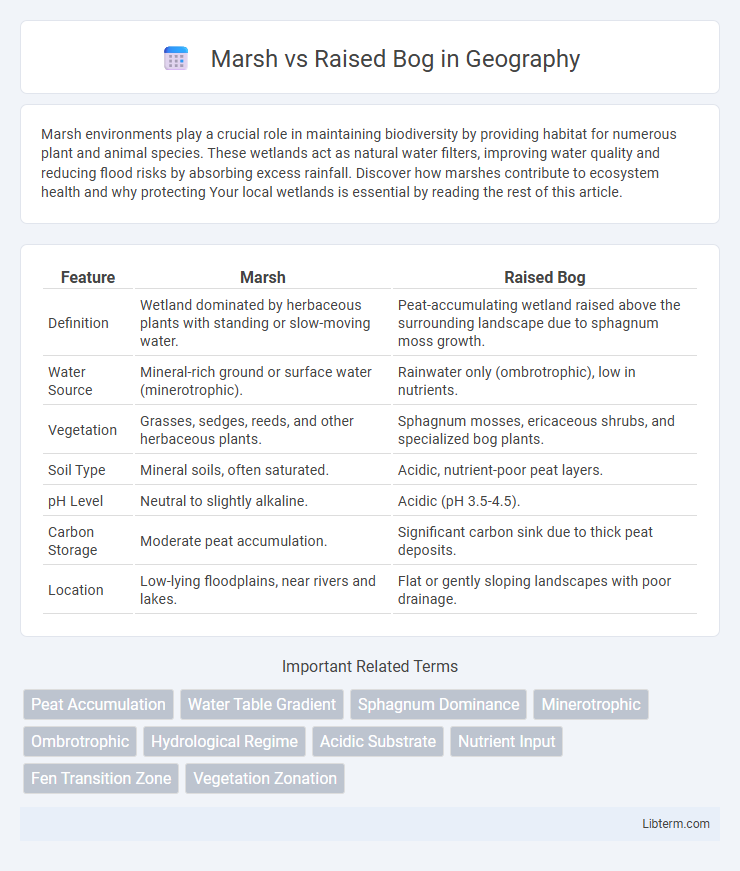Marsh environments play a crucial role in maintaining biodiversity by providing habitat for numerous plant and animal species. These wetlands act as natural water filters, improving water quality and reducing flood risks by absorbing excess rainfall. Discover how marshes contribute to ecosystem health and why protecting Your local wetlands is essential by reading the rest of this article.
Table of Comparison
| Feature | Marsh | Raised Bog |
|---|---|---|
| Definition | Wetland dominated by herbaceous plants with standing or slow-moving water. | Peat-accumulating wetland raised above the surrounding landscape due to sphagnum moss growth. |
| Water Source | Mineral-rich ground or surface water (minerotrophic). | Rainwater only (ombrotrophic), low in nutrients. |
| Vegetation | Grasses, sedges, reeds, and other herbaceous plants. | Sphagnum mosses, ericaceous shrubs, and specialized bog plants. |
| Soil Type | Mineral soils, often saturated. | Acidic, nutrient-poor peat layers. |
| pH Level | Neutral to slightly alkaline. | Acidic (pH 3.5-4.5). |
| Carbon Storage | Moderate peat accumulation. | Significant carbon sink due to thick peat deposits. |
| Location | Low-lying floodplains, near rivers and lakes. | Flat or gently sloping landscapes with poor drainage. |
Understanding Wetlands: Marsh vs Raised Bog
Marshes are wetlands characterized by herbaceous plants and nutrient-rich, often alkaline waters, supporting diverse wildlife such as reeds, cattails, and various bird species. Raised bogs are peat-forming wetlands with acidic, nutrient-poor conditions, dominated by sphagnum moss and specialized plants adapted to low-nutrient environments. Understanding the ecological differences between marshes and raised bogs is essential for wetland conservation and management, as their hydrology, vegetation, and carbon storage capacities vary significantly.
Key Differences Between Marshes and Raised Bogs
Marshes are wetlands characterized by nutrient-rich, mineral soils and dominated by herbaceous plants such as reeds and grasses, supporting diverse wildlife and frequent water flow. Raised bogs are peat-accumulating wetlands with acidic, nutrient-poor conditions, primarily covered by sphagnum mosses and forming elevated hummocks due to peat buildup. Unlike marshes, raised bogs receive water mainly from precipitation rather than groundwater, resulting in distinct hydrology and vegetation adapted to low nutrient availability.
Formation Processes of Marshes and Raised Bogs
Marshes form in low-lying areas where water accumulates, leading to the growth of herbaceous plants like reeds and grasses, driven by surface water inputs and periodic flooding. Raised bogs develop over millennia in waterlogged conditions, primarily from the accumulation of sphagnum moss peat, causing the bog surface to rise above surrounding landscapes through peat buildup. The anaerobic, acidic environment in raised bogs slows decomposition, enabling thick peat formation, in contrast to marshes where nutrient-rich waters support more rapid organic matter turnover.
Hydrology and Water Sources Comparison
Marshes are wetlands fed primarily by surface water, rainfall, and groundwater, resulting in nutrient-rich and oxygenated conditions that support diverse plant and animal life. Raised bogs receive water mainly from precipitation, leading to acidic, nutrient-poor, and waterlogged environments dominated by sphagnum mosses. The hydrology of marshes involves frequent water exchange with surrounding landscapes, while raised bogs maintain a dome-shaped peat accumulation that isolates them hydraulically, creating unique anoxic conditions.
Vegetation and Biodiversity in Marshes vs Raised Bogs
Marshes predominantly host herbaceous plants such as sedges, cattails, and reeds, supporting high biodiversity with abundant insects, amphibians, and bird species adapted to nutrient-rich, waterlogged soils. Raised bogs feature specialized vegetation including sphagnum mosses, ericaceous shrubs, and carnivorous plants, thriving in nutrient-poor, acidic conditions and sustaining unique fauna adapted to low-nutrient environments. The contrasting plant communities and soil chemistry between marshes and raised bogs drive distinct ecological niches and biodiversity patterns crucial for wetland ecosystem functioning.
Soil Composition and Peat Development
Marsh soils are typically mineral-rich with higher sand, silt, and clay content, supporting diverse vegetation and slower peat accumulation. Raised bogs consist primarily of acidic, nutrient-poor peat formed from Sphagnum mosses, creating thick, organic layers that develop over thousands of years through waterlogged conditions. Peat in raised bogs is well-decomposed and highly acidic, whereas marsh peat is less developed and mixed with mineral sediments.
Wildlife Habitat: Species Unique to Each Wetland
Marshes support diverse species such as frogs, herons, and dragonflies that thrive in the nutrient-rich shallow waters and abundant vegetation. Raised bogs provide a unique habitat for acid-tolerant plants like sphagnum moss, sundews, and specialized fauna including certain dragonfly species and bog-specific birds like the rare golden plover. Each wetland's distinct hydrology and nutrient availability shape the specialized wildlife adapted to these environments.
Ecological Roles and Environmental Benefits
Marshes and raised bogs both play crucial ecological roles by supporting diverse ecosystems and enhancing water quality. Marshes act as natural water filters by trapping sediments and absorbing nutrients, while raised bogs sequester significant amounts of carbon in their peat layers, mitigating climate change. The waterlogged conditions in marshes support numerous aquatic species, whereas raised bogs provide unique habitats for specialized plants like sphagnum moss and rare wildlife adapted to acidic, nutrient-poor environments.
Threats and Conservation Challenges
Marshes face threats from agricultural drainage, urban development, and pollution that disrupt water flow and degrade habitat quality. Raised bogs are vulnerable to peat extraction, industrial pollution, and climate change, which alter hydrology and reduce carbon storage capacity. Conservation challenges include restoring natural water regimes, preventing invasive species, and implementing sustainable land-use practices for both wetland types.
Importance in Climate Regulation and Carbon Storage
Raised bogs store significant amounts of carbon in their thick peat layers, acting as vital carbon sinks that help mitigate climate change by sequestering atmospheric CO2 over millennia. Marshes, while supporting diverse ecosystems and providing important water filtration, typically store less carbon due to more frequent decomposition and nutrient cycling. The preservation and restoration of both wetland types are crucial for maintaining regional climate stability and enhancing carbon storage capacity in natural landscapes.
Marsh Infographic

 libterm.com
libterm.com